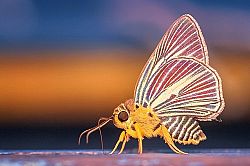

Moths are seen to be declining in abundance by near to 10% each continuing decade in Britain, but the remaining ones are growing in average weight, currently seen as double of what it was in 1967, for moths caught in traps.
Researchers that were studying the biomass of moths that were caught, as part of the worlds longest running insect survey, has claimed that their findings suggested that if there was a possibility of an "insect Armageddon" in Britain, it would likely have occurred before scientific recording started in 1967. Rather than seeing a steep decline, those studying at the University of York had found that moth populations had boomed following a strong heatwave - though there has been a steady decline in their abundance since 1982 - they remain with twice as high a biomass since 1967.
This new analysis showing a continuous slump of moth populations since the 1980s, matches correctly to that of other insect studies, showing a more dramatic decline as of late. Stating that everything is not fine, Dr Callum Macgregor has said, "We do know that insects are in long-term decline as a whole, and also that the majority of inset species are declining. The concerning thing about the decline is that it's over a 35-year period and there's no real sign that that long-term declining trend is reversing."
He continues to explain, "the implication of a phrase like 'insect Armageddon' is that it's an end-of-days scenario and it's almost hopeless." He instead believes this is not the right phrasing to use, and that there is still both time and opportunity where we can change things around - as well as looking to make positive changes in the way that land is used. The study, published in Nature Ecology and Evolution, calculated the biomass of moths caught in 34 different light traps - they have been operating every night for at least 30 years as part of the Rothamsted Insect Survey, that began back in 1967.
Biomass is an important measure, as it signals the number of moths that are available to pollinate plants and to provide food for birds, bats and small mammals. Those that study it, believe that moth declines are likely to mirror falls in the populations of other flying insects. Two of the most common causes that were given for the decline of moths are either agricultural intensification or light pollution in urban areas. The study found that traps in urban areas, as well as on arable land, caught a far lower abundance of moths than those in both grassland and woodland.
Between 1983 and 2017, the average weight of the moths caught in a trap each year was about:
Moths biomass remained stable on arable land, but fell by 18% since 1983 in grassland, and by 15% in the woodland.
According to Macgregor, this can show that the chemical-sensitive species had already been removed from the farmland, as a result of the agricultural chemicals used throughout the 1960s before the Rothamstead survey had begun. Commenting on this theory, Macgregor had said, "A lot of our farmland was pretty intensively farmed already by 1967, so species that were going to be driven out by agriculture might have already gone by the time of the beginning of this dataset. If we went back to 1930 or 1850 there could be a massive decline, but there's not any way to know that, unfortunately."
This study has shown there has been a slow, and steady decline since 1982 and there has been a considerable fluctuation that occurred through the years - these are believed to be caused by either extreme weather and climatic changes. It appears as though the dry weather mixed with a heatwave in 1976 caused a massive boom in British insect populations - this then continued, until the mid-1990s when a crash of average biomass dropped the results to first, 93,100 milligrams and then at its lowest of 45,773 milligrams in 1998. It stabilised at around 50,000 milligrams on the turn of the century.